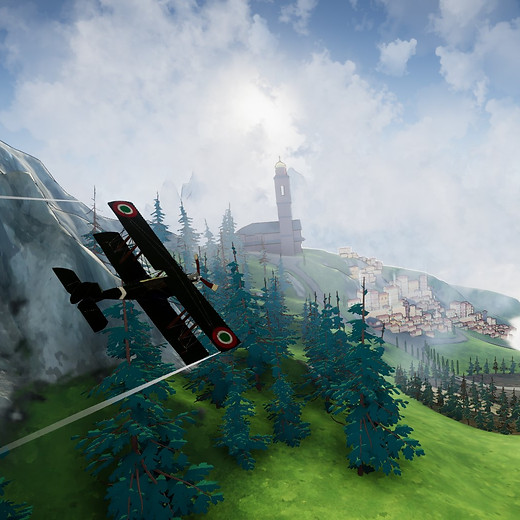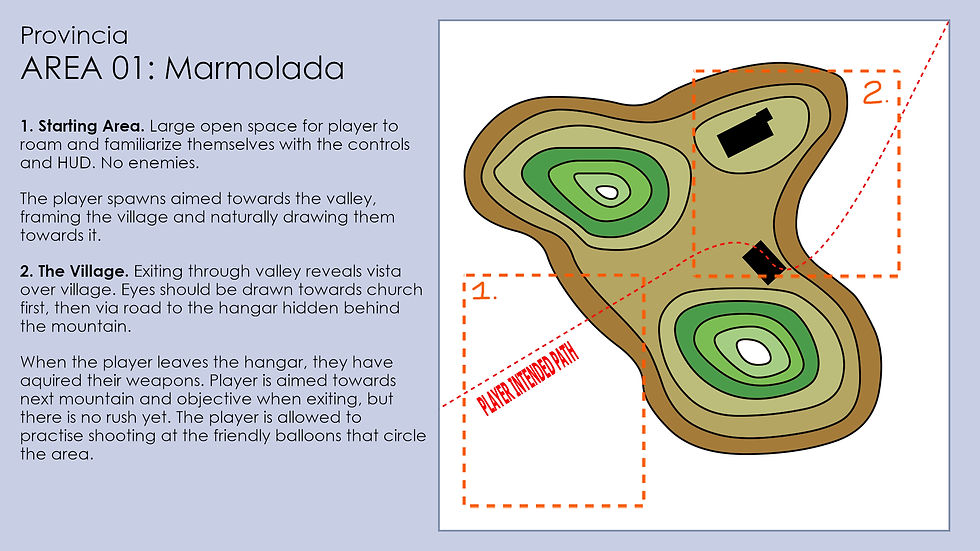
PROVINCIA
GAME DESIGN - WORLD DESIGN - NARRATIVE - SOUND
2019



OVERVIEW
Provincia is a high-octane aerial dogfighting game with a distinct early 20th century aesthetic.
The goal of the project was to create a vertical slice of a semi-realized open-world game with intuitive arcade-style controls that anyone can pick up and play, set in a believable world and environment.
The game centres around completing missions for different nuanced characters, earning money and upgrading your aircraft.
The game was displayed at both Gotland Game Conference and at the Swedish Game Awards in 2019, where it was nominated for Best Execution in Audio.

GENRE
Open World, Action, Simulation
ENGINE
Unity
TEAM SIZE
7
DURATION
10 weeks
PLATFORM
PC


CONTRIBUTIONS
GAME DESIGN
Gameplay design and mechanics
WORLD DESIGN
Level and mission design
NARRATIVE
Story writing and dialogue
SOUND
Sound effects and music
PRODUCT OWNER
Project vision and backlog
GAMEPLAY VIDEO

GAMEPLAY
Provincia centres around adventure and combat. Being a vertical slice project, we imagined it as a gameplay demo for a larger game.
The player is given a mission at the start of the game that takes them through 3 different combat encounters, a bounty hunting target, a boss fight as well as an aircraft upgrade opportunity.
On their adventure, the player receives narrative exposition through radio messages, giving context to the whole experience.
Follow the link below to view the initial One-page design document for the concept.
MOVEMENT
Since we wanted players to be able to pick the game up easily and master it within minutes, the controls needed to be intuitive, minimalistic and responsive.
The player is able to steer the plane using only the left stick of the controller. By removing the right stick from the player's attention, he/she is able to focus and learn the controls faster and stay in the state of flow easier.
Furthermore, instead of controlling the plane directly, the player controls a crosshair that the plane actively flies towards. This allowed for smoother steering, as well as easier aiming and shooting during combat.

DRIFTING
To give the gameplay a faster pace and greater impact, a drift mechanic was introduced. By holding the left trigger, the player can lock the momentum of the plane and rotate it freely to make instant turns, dodges or maneuvers.
Boosting
The player is able to activate an afterburner that increases the plane's speed significantly for a short period of time. This was implemented to give the player a way of both engaging targets and evading them more efficiently. When combined with the drift mechanic, the controls became incredibly explosive.
WEAPONS
There are three unique weapons in the game. One primary and two secondary. The secondary weapons are swapped using the Y button.
The different weapons all fill a certain niche and playstyle.
The player can equip them by returning to and landing at a nearby friendly hangar.
MACHINE GUN
Primary weapon. Ranged, rapid firing and reliable.
MISSILE LAUNCHER
Secondary weapon. Fires a homing rocket. Ranged and powerful, but slow to reload.
SHOTGUN
Secondary weapon. Fires in a cone in front of the aircraft. Very short ranged, but incredibly powerful.

LEVEL DESIGN
LEVEL LAYOUT
Provincia is set high above the ground around different mountain peaks. For the sake of the vertical slice, we created two mountains, to emulate what the larger project would have looked like.
We used the shapes of the mountains to guide the player naturally through the level. We found that players generally would follow valleys and seldom move drastically on the Y-axis, so I used that to our advantage when designing the areas.
MISSION STRUCTURE
I wanted the player's mission to really encapsulate and represent what the larger game would be like, so I imagined each mission objective as if they were quests in a true open-world game.
As with most action oriented games, a good intensity curve becomes important, and combat encounters were placed and timed accordingly. The mission objectives takes the player from one mountain, through the next and back again, finishing in a grand scale boss fight.




NARRATIVE
The narrative in Provincia is delivered to the player through radio messages displayed on screen during gameplay. Inspiration were taken from Star Fox and Ace Combat.
Messages where tied to events in the gameplay, such as the player entering a new area or when an area had been cleared of enemies.
The writing style of the game is loose and comedic in nature, so as to better play with the more high-energy aspect of the game. I focused less on writing a well-developed story, and more on creating interesting and quirky characters.
I also created all of the 2D art in the messages.






SOUND
The sound design in the game was built partly from bought assets, but mostly from actual recordings that I made using equipment borrowed from a streaming studio at my campus in Visby. I recorded a plethora of metallic and mechanical objects and tools and layered them together for different effects.
I used FL Studio for post-processing and editing. The sounds were then implemented into the game using FMOD, where sound where looped and manipulated using variables and perimeters from Unity.
The sound of the afterburner, for example, is a looped recording of a canister of compressed air filtered through a distorter and a phaser pedal to make it sound like a roaring jet engine.
MUSIC
Provincia's soundtrack was written and produced entirely by me using FL Studio and Kontakt 5.
For the soundtrack, I wanted a strong dynamic between the calmer, explorative sections of the game and the more intense combat sections.
DYNAMIC SOUNDTRACK
The soundtrack is also highly dynamic and the music changes according to many different perimeters, such as player health, position, enemy presence, etc.
FMOD was used to create this system.
